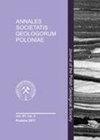Implications of brecciation in Pennsylvanian Atoka Bank complex carbonates, Eddy County, New Mexico
IF 0.9
4区 地球科学
Q2 GEOLOGY
引用次数: 0
Abstract
The Pennsylvanian Atoka bank carbonates were deposited on the northwest shelf of the Delaware Basin in Eddy County, New Mexico, forming a stratigraphic trap for natural gas. Brecciation is common in the core samples of some wells. This paper describes the brecciation in the phylloid algal limestones and discusses its origin. In the core samples, brecciated dark areas, consisting of irregularly shaped fragments, are seen together with internal sediment-filled pores, characterized by light gray coloured areas. Detailed examination of the core samples reveals that the brecciated dark areas correspond to open space areas between phylloid algal colonies, on the basis of comparison with the well-preserved primary rock texture in the cores. Brecciation is mainly due to the selective dissolution of phylloid algae that produced phylloid algal moulds, later filled by sandy internal sediments under subaerial conditions. The subsequent compaction of the limestone caused the rock to break up and formed a breccia in situ . The sandy internal sediment prevented the moulds from collapse as well as breccia formation in the pore-filling area, owing to its loose character. Overall, the brecciation process, including the dissolution of phylloid algae and breakage of the rocks, significantly improved the reservoir quality, whereas the internal sediment reduced the reservoir quality, for it reduced the porosity.新墨西哥州埃迪县宾夕法尼亚Atoka Bank复杂碳酸盐岩角化作用的意义
宾夕法尼亚Atoka滩碳酸盐岩沉积在新墨西哥州Eddy县Delaware盆地的西北陆架上,形成了天然气的地层圈闭。角化作用在某些井的岩心样品中很常见。本文描述了叶状藻灰岩中的角化作用,并讨论了角化作用的成因。在岩心样品中,角化的深色区域,由不规则形状的碎片组成,与内部充满沉积物的孔隙一起被看到,其特征是浅灰色区域。对岩心样品的详细检查表明,角化的暗区与保存完好的原始岩石结构相比较,对应于叶状藻菌落之间的开放空间区域。角化作用主要是由于叶状藻选择性溶解产生叶状藻霉菌,随后在陆上条件下被砂质内部沉积物填充。随后石灰岩的压实作用使岩石破碎,在原地形成角砾岩。砂质内沉积因其松散性,使充填区不能形成角砾岩,也不能塌陷。总体而言,叶状藻类的溶解和岩石的破碎等角化作用显著改善了储层质量,而内部沉积物降低了孔隙度,降低了储层质量。
本文章由计算机程序翻译,如有差异,请以英文原文为准。
求助全文
约1分钟内获得全文
求助全文
来源期刊
CiteScore
2.60
自引率
7.70%
发文量
6
审稿时长
>12 weeks
期刊介绍:
Annales Societatis Geologorum Poloniae (ASGP) is the scientific journal of the Polish Geological Society. Original contributions and review articles are considered for publication in Annales Societatis Geologorum Poloniae. Submissions for publication may be from all branches of the geological sciences, including applied and economic geology, as well as discussions of papers, previously published in the journal. The language of the journal is English.

 求助内容:
求助内容: 应助结果提醒方式:
应助结果提醒方式:


